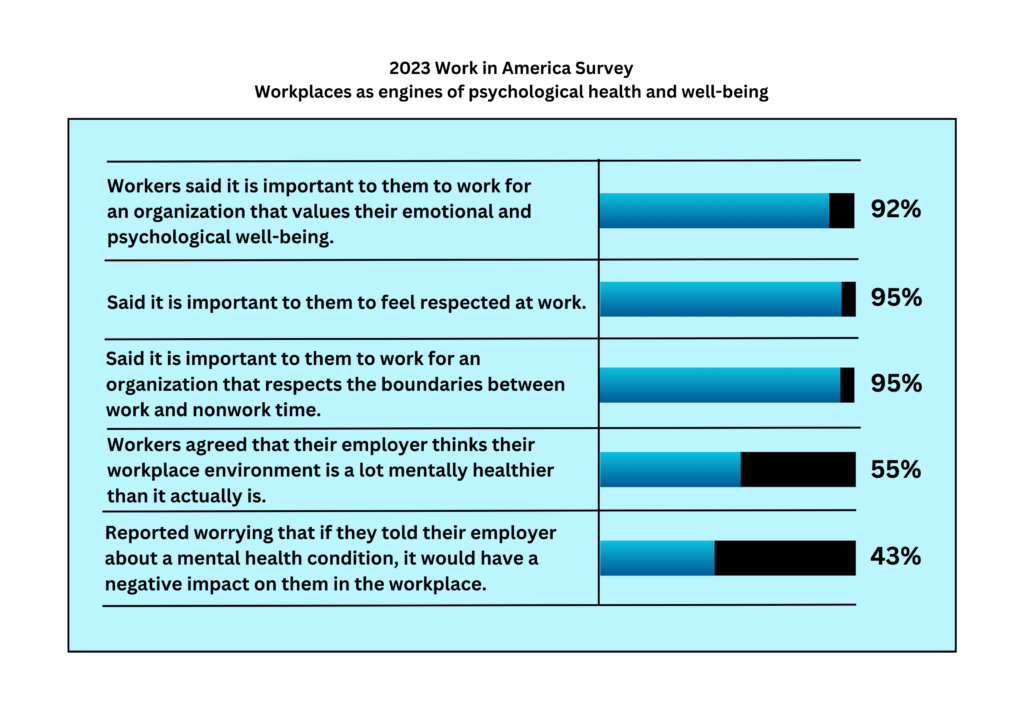
It has been almost 3 years since the COVID-19 pandemic shook the foundation of our society to its core. The lingering effects of the pandemic are still taking a toll on the mental and emotional health of employees and their families. What started as a viral outbreak has morphed into a mental health crisis. Although employee health has always been a curious case of corporate culture, the changing landscape of workplaces has drawn heightened attention to the needs and expectations of workers across the nation when it comes to employee well-being. Below are the findings of Work In America survey conducted in 2023:

Workplace stress still remains a major problem, with nearly 8 out of 10 workers reporting that they experienced it in the past month. Additionally, more than half of workers reported experiencing negative impacts of work-related stress, such as emotional exhaustion, lack of motivation, social withdrawal, thoughts of quitting, conflict with coworkers, and feelings of inadequacy. These are all signs of workplace burnout creating a strong case for employee well-being.
Employee well-being is essential for any organization that wants to succeed. Happy and engaged employees are more productive, more creative, and more likely to stay with the company. They are also more likely to provide excellent customer service.
Take the case of Mojang Studios, the developer of the popular video game Minecraft. Theirs is a great example of how prioritizing employee well-being can lead to better business outcomes. In 2021, the studio faced a choice: ask employees to work overtime to quickly complete an update to capitalize on the current spike in gaming interest, or prioritize employee well-being by keeping to the original timeframe. The studio opted for the latter, splitting its update into two parts, with the second released a month ahead of the holidays.
By the end of the year, the studio was receiving rave reviews for the update and player experience. This validated its leaders’ decision to focus on their employees’ health and engagement, and ultimately highlighted the strong link between employee experience (EX) and customer experience (CX).
Consider Your Employees As Your First Customers
There are at least four ways in which you can prioritize employee well-being to foster a better customer experience:
Lead with empathy: Leaders must begin from a place of empathy and make a pronounced and consistent effort to connect with their team in order to understand their state of well-being.
Act on feedback: Actively solicit employee feedback and make changes based on what you learn.
Support growth and development: Offer employees opportunities to upskill and progress their careers.
Encourage physical activity: Promote physical activity and mental health programs to support all-around better health.
When organizations prioritize employee well-being, they create a more positive and productive work environment. This leads to happier employees, better customer service, and stronger financial performance.
Here are some specific examples of how organizations can implement these strategies:
Flexible work arrangements allow employees to work from home or adjust their hours to better meet their personal needs. This can be a major benefit for employees with families, caregivers, or other commitments outside of work. It can also contribute to employee well-being by helping them to be more productive and engaged, as they are able to work when and where they are most productive.
Here are some specific examples of flexible work arrangements:
Mental health is just as important as physical health, but it is often overlooked in the workplace. By providing mental health resources to employees, organizations can help to create a more supportive and healthy work environment.
Here are some examples of mental health resources that organizations can provide:
It is important for employees to take breaks throughout the day and to take vacations when they need them. This allows employees to recharge and come back to work refreshed and productive.
Here are some tips for encouraging employees to take breaks and vacations:
Recognizing and celebrating employee achievements is a great way to boost morale and improve employee engagement. When employees feel valued and appreciated, they are more likely to be happy and productive at work.
Here are some ways to celebrate employee successes:
Prioritizing employee well-being is not only the right thing to do, but it is also good for business. When employees are happy and healthy, they are more likely to be productive, engaged, and loyal. This leads to better customer service, increased profits, and a stronger bottom line.
The results released by XpertHR and Executive Networks in the US and UK reveal how gender biases are influencing transparency discussions...
AI is intruding into the domain of recruiting with the help of AI the world of Recruiting candidates for jobs is going to be changed.